Dental Implants
Your Third Set of Teeth
(Continued)
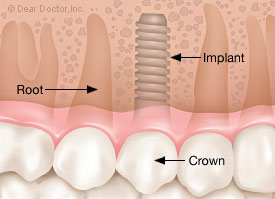 |
|
Figure 2: Illustration showing an example of a full crown restoration placed on an individual implant.
|
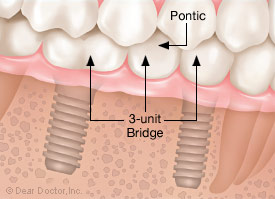 |
|
Figure 3: Illustration showing an example of a 3-unit bridge with a pontic (replacement tooth) placed between two implant crowns.
|
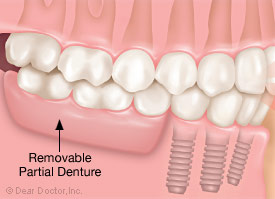 |
|
Figure 4: Illustration showing an example of a permanent bridge supported by multiple implants which has attachments for a removable partial denture.
|
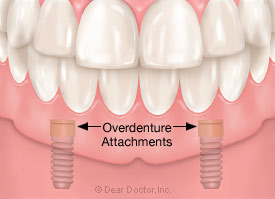 |
|
Figure 5: Illustration showing an example of two implants for attachment and stabilization of the mandibular denture protecting the underlying bone.
|
 |
|
Figure 6: Illustration showing an example of a how an implant can be used for anchorage during orthodontic therapy to straighten tipped teeth.
|
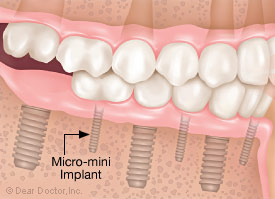 |
|
Figure 7: Illustration showing micro-mini “temporary” implants providing a non-removable temporary bridge while permanent implants attach to the underlying bone.
|
One and Two Stage Systems
In some implant systems the implants are placed, covered with the gum tissue and left to integrate or fuse to the bone. In these two stage systems, the implant is uncovered (stage two) and a small connector, called a “healing abutment” is attached to the implant which connects it to the mouth above the gum. The gum tissue heals around it. After a 4-6 week period crowns can be fabricated for tooth replacement. In the one stage system the implant is left exposed at surgery, slightly protruding through the gum tissue. The two stage systems are initially more protective, however each system has its place, merits and indications.
Types of Implants and Restorations
There are now more than 40 different types of what can now be termed traditional or standard implants available today. There are also two others, mini and micro-mini implants. Mini implants are like traditional implants but usually smaller in diameter where as micro-mini implants are a variation of the now more traditional implant design, but smaller, narrower and more screw like in appearance, they are more temporary in nature and designed to be easily removed.
Types of Implant Restorations:
- Single tooth replacements: use one implant and as the name suggests support a single crown [Fig. 2].
- Multiple tooth replacements: multiple missing teeth can be replaced with multiple implants supporting fixed bridgework as small as a 3-unit bridge supported by two implants, or with multiple implants supporting a greater number of teeth. Usually a minimum number of 4-8 implants are needed to replace a full arch (jaw) of teeth, 10 or more crowns by fixed bridgework [Fig. 3].
- Combinations of fixed and removable bridgework: generally where implants are used to support a section of fixed bridgework, to which is attached a removable section [Fig. 4].
- Over-dentures: where two or more implants, either standard or mini-implants, are placed to provide stabilization of the denture and preserve the underlying bone. Whereas most traditional full dentures press directly on the gum and bone causing bone loss by resorption, implant supported over-dentures protect the bone. Over-dentures are now considered the standard of care by the American Dental Association for the patients who have lost all of their teeth in one or both jaws [Fig. 5].
- Anchorage for tooth movement (orthodontics): Implants, either standard, mini, or micro-mini implants, are now being used to provide very stable and non-movable anchor units to allow quicker and easier tooth movement [Fig. 6].
- Temporary bridgework: utilize micro-mini implants which are later removed when the permanent implants are healed and teeth permanently replaced. They ensure that at no time will a person be without teeth and can therefore be socially comfortable and functional [Fig. 7].
Your dentist will select the type of implant that has been evaluated for bio-compatibility, supporting research and to provide tooth replacement.









